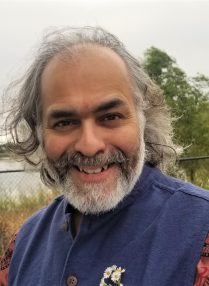Dev Niyogi
November 3, 2020

Growing up, Dev Niyogi had no idea how much his childhood in India would affect his future career path. As a child interested in math and science, he expected to join many of his friends in computer engineering. However, after getting his undergraduate degree in engineering, Niyogi decided to earn a doctorate in atmospheric science from North Carolina State University in 2000.
“I was always fascinated by the lively motion in the atmosphere. I grew up in monsoon region, where I’ve seen heavy rains, experienced cyclones, experienced floods. If it rained, you grabbed an umbrella. If it flooded, you found roads that were safe. It was normal life,” Niyogi said. “The notion that you could do something to change things was brewing into my thinking. It was only later that I started finding ways to transform this thinking, that maybe things don’t have to be the way they are.”
This fall, Niyogi joined the Jackson School of Geosciences faculty. He holds the John E. “Brick” Elliott Centennial Endowed Professorship in Geological Sciences. He is also part of the faculty at The University of Texas at Austin Cockrell School of Engineering and a theme organizing committee member of Planet Texas 2050, a UT Bridging Barriers initiative that seeks to apply research on the environmental challenges facing Texas to the world.
Before joining UT, he spent 15 years as faculty at Purdue University. During most of that time, he also served as the state climatologist of Indiana.
Niyogi’s Ph.D. research was among the first to introduce carbon dioxide and land use feedbacks into weather forecast models. Shortly after earning his doctorate, he participated in a workshop at the Aspen Institute on the concept of how land affects climate. This resulted in a seminal research paper that led to the addition of land use changes into climate models.
Recently, Niyogi’s research has focused on the complex relation between human decisions, weather and regional climate. An example is the tendency of thunderstorms to break up into “beltway storms” as they approach a city so that the places around its periphery experience rainfall and potential damage. Niyogi said that understanding the links between cities, landscape, human decisions and climatic extremes can help improve the habitability and resiliency of communities.
“I’m hoping that we take this science, this knowledge, and the engineering approaches, and somehow marry it and come up with a framework that can be used as a template for improving lives,” Niyogi said.
